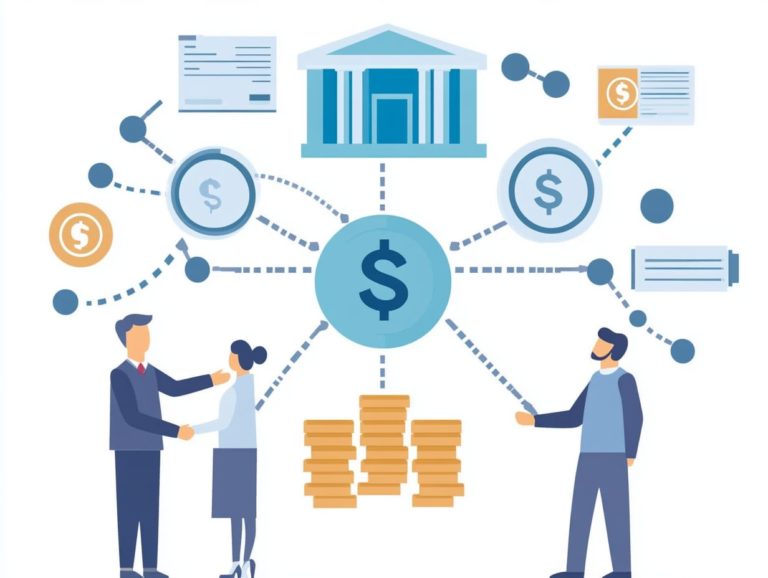Peer-to-Peer Lending: Making Sense of Interest Rates
Peer-to-peer lending has become an innovative avenue for borrowing and lending money beyond the confines of traditional banks. This approach presents unique advantages and challenges along the way.
Grasping the details of interest rates within this framework is crucial for both borrowers and investors. This article will help you unlock the secrets of peer-to-peer lending, looking at the factors that affect interest rates and comparing them to traditional lending options.
You ll uncover strategies for securing the best rates while also learning to assess and manage potential risks. Get ready to dive into the exciting world of peer-to-peer lending!
Contents
- Key Takeaways:
- What is Peer-to-Peer Lending?
- How Interest Rates are Determined in Peer-to-Peer Lending
- Comparing Interest Rates in Peer-to-Peer Lending to Traditional Lending
- Tips for Finding the Best Interest Rates in Peer-to-Peer Lending
- Understanding the Risks of Peer-to-Peer Lending Interest Rates
- Frequently Asked Questions
Key Takeaways:

Peer-to-peer lending offers an alternative to traditional lending by directly connecting borrowers and lenders through online platforms.
Interest rates in peer-to-peer lending are determined by various factors, including credit risk, loan term, and borrower demand.
While peer-to-peer lending may offer higher interest rates for lenders, it also carries potential risks such as default and platform failure.
What is Peer-to-Peer Lending?
Peer-to-peer (P2P) lending represents a transformative financial landscape, connecting you directly with investors via online platforms while bypassing traditional banks and financial institutions.
This approach helps you get personal loans based on your credit history, while simultaneously offering compelling investment opportunities for those eager to expand their assets.
By leveraging platforms such as LendingClub, FundingCircle, Prosper, and Upstart, you can access competitive loan terms. As an investor, you can thoughtfully diversify your portfolio within the realm of alternative loans.
Explanation of the Concept
P2P lending is a financing model that allows you, whether as an individual or a business, to secure loans directly from investors, bypassing traditional banking intermediaries.
This innovative approach enables you to list your loan requests on online platforms, where potential lenders can peruse your detailed profile.
Typically, these profiles include essential information like credit scores, income verification, and the purpose of the loan, all of which help investors gauge your credibility.
The process involves evaluating various factors, including your repayment history and overall financial health, to craft a comprehensive risk profile.
Once you list your loan, multiple investors can choose to fund it, either partially or in full, which helps spread out the risk. It s essential for both you and the investors to grasp the inherent risks involved, such as borrower default and market fluctuations, that could affect returns.
How Interest Rates are Determined in Peer-to-Peer Lending
In peer-to-peer lending, interest rates are primarily shaped by evaluating the borrower’s credit score and risk profile, alongside the prevailing market conditions, which is crucial for understanding the peer-to-peer lending process.
Considerations like loan amounts, repayment terms, and borrower qualifications play a crucial role in determining these rates. This careful assessment ensures that investors can secure adequate returns while borrowers gain access to the funds they require.
The distinctive characteristics of P2P lending create an environment where interest rates can be more competitive than those offered by traditional lending institutions, raising questions about the ethics of peer-to-peer lending.
Factors that Influence Interest Rates

Several factors influence the interest rates you encounter in peer-to-peer lending, such as your credit history, the competition among lenders, and the specific loan criteria established by the platform. To gain a deeper understanding of these elements, including peer-to-peer lending fees and costs, it’s essential to do your research.
These elements collectively shape the borrowing landscape. A strong credit history can lead to more favorable rates, while a poor credit score may mean higher costs for you as a borrower.
When multiple lenders compete for the same pool of borrowers, this competition tends to drive rates down, ultimately resulting in better terms for you.
This dynamic is crucial, not only for securing funding but also for how investors view the potential returns on their investments.
Understanding these factors can greatly affect your financial choices, whether you’re borrowing or investing.
Comparing Interest Rates in Peer-to-Peer Lending to Traditional Lending
When you compare interest rates in peer-to-peer lending with those from traditional lending institutions, you ll quickly notice that peer-to-peer (P2P) platforms often offer more competitive options for personal and unsecured loans.
This advantage largely stems from the elimination of intermediaries, which allows for better rates for you as a borrower. It also provides attractive returns for investors.
As a result, peer-to-peer lending has established itself as a viable alternative for individuals seeking flexible financial solutions.
Pros and Cons of Peer-to-Peer Lending Interest Rates
Peer-to-peer lending interest rates have both advantages and challenges. It is essential for you to carefully assess your options as a borrower or investor by referring to understanding peer-to-peer lending.
On one hand, you might find that peer-to-peer platforms often offer lower interest rates compared to traditional banks. This can lead to substantial savings over time.
If you have good credit, you could secure a loan at an attractive rate. This would allow you to consolidate debt or finance a major purchase with ease.
As an investor in peer-to-peer lending, you can earn higher returns on your money, since your funds are lent directly to individuals or small businesses in need.
However, the risk of loan defaults is significant. This highlights the importance of seeking thorough financial guidance before diving into these platforms.
You need to be aware of the risk of loan defaults and understand the implications of interest rates to make informed decisions in this innovative lending landscape.
Tips for Finding the Best Interest Rates in Peer-to-Peer Lending
To discover the most favorable interest rates in peer-to-peer lending, prioritize enhancing your credit score. Additionally, carefully compare loan offers from various online lenders.
By understanding the details of each platform and leveraging your financial profile, you can secure ideal funding options that align perfectly with your objectives.
Strategies for Maximizing Returns

To maximize your returns in peer-to-peer lending, focus on assessing borrower profiles and diversifying your investment portfolio across various loans.
By looking closely at the repayment terms associated with each loan, you can identify borrowers who pose the lowest risk and offer the highest potential for reliable payments.
Keeping an eye on emerging trends in borrower behavior and economic factors will provide valuable insights into promising investment opportunities.
Leveraging risk assessment tools and staying updated on market conditions will enable you to make strategic decisions.
It s essential to balance higher-risk loans with safer options. This ensures a stable growth trajectory while capitalizing on the lucrative returns that the peer-to-peer lending market offers.
Understanding the Risks of Peer-to-Peer Lending Interest Rates
Are you aware of the hidden risks in peer-to-peer lending? Grasping the risks tied to interest rates is essential for you, whether you’re a borrower or an investor looking to understand what to expect from peer-to-peer lending returns.
You need to be aware of the risk of loan defaults and the diverse investment risks that may arise.
By performing diligent risk assessments and seeking expert financial guidance, you can navigate the peer-to-peer lending landscape and make informed strategic decisions.
Assessing and Managing Potential Risks
Assessing and managing potential risks in peer-to-peer lending requires you to understand the likelihood of loan defaults. It is also important to evaluate the strength of the financial institutions and credit unions involved in the lending process.
To effectively mitigate these risks, analyze borrower profiles, including credit scores, income stability, and past borrowing history. This thorough examination allows you to gauge a borrower s ability to repay loans.
The role of financial institutions is essential; they provide funding and offer risk assessment tools that enhance your evaluation process. By fostering collaboration between borrowers and lenders and integrating advanced analytics, you can create a more secure lending environment.
This ensures a balanced risk-reward ratio that appeals to everyone involved.
Frequently Asked Questions
What is Peer-to-Peer Lending?

Peer-to-peer lending lets you borrow money directly from other people. Forget banks; this modern approach connects you with individual lenders who want to help.
How Does Peer-to-Peer Lending Work?
Borrowers apply for loans on online platforms. Lenders choose which loans to fund based on the borrower’s credit score and purpose.
What Are Interest Rates in Peer-to-Peer Lending?
Interest rates are the annual percentage rates (APRs) you pay for the loan. They depend on your credit score and the risk of the loan.
How Are Interest Rates Determined?
Your credit score, income, and debt-to-income ratio determine your interest rate. A higher credit score usually means a lower interest rate.
The loan s risk level and current market conditions also affect rates.
Fixed vs. Variable Interest Rates
A fixed interest rate stays the same throughout the loan. A variable rate can change based on market conditions. Fixed rates offer predictability, while variable rates may save you money if rates drop.
Are There Fees with Peer-to-Peer Lending?
Yes, expect fees like origination and late payment fees. These vary by platform, so review the fee structure carefully before choosing where to borrow or invest.






